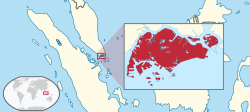Raja of Singapura
| Kingdom of Singapura | ||||||||||
| Kerajaan mlay | ||||||||||
|
||||||||||
|
Location of Kingdom of Singapura (red)
|
||||||||||
| Capital | Singapura | |||||||||
| Languages | Old Malay | |||||||||
| Religion | Syncretic form of Hinduism, Buddhism and Animism; Islam | |||||||||
| Government | Monarchy | |||||||||
| King | ||||||||||
| • | 1299–1347 | Sang Nila Utama (Sri Tri Buana) | ||||||||
| • | 1347–1362 | Sri Wikrama Wira | ||||||||
| • | 1362–1375 | Sri Rana Wikrama | ||||||||
| • | 1375–1389 | Sri Maharaja | ||||||||
| • | 1389–1398 | Parameswara (Sri Iskandar Shah) | ||||||||
| History | ||||||||||
| • | Founding of Temasek by Sang Nila Utama | 1299 | ||||||||
| • | Siege by Siam | 1349 | ||||||||
| • | Siege by Majapahit under Hayam Wuruk | 1350 | ||||||||
| • | Majapahit Invasion and escape of Parameswara (Sri Iskandar Shah) to the Malay Peninsula | 1398 | ||||||||
| Currency | Native gold and silver coins | |||||||||
|
||||||||||
| Today part of |
|
|||||||||
The Kingdom of Singapura (Malay: Kerajaan Singapura) was a Malay kingdom thought to exist on the island of Singapore from 1299 until its fall in 1398. Conventional historical view marks circa 1299 as the founding year of the kingdom by Sang Nila Utama (also known as "Sri Tri Buana"), whose father is Sang Sapurba, who according to legend is the common great ancestor of most of the Malay monarchies in the Malay World. The historicity of this kingdom, based on the account given in the Malay Annals, is the subject of academic debates. However, archaeological excavations on Fort Canning and its vicinity along the banks of the Singapore River since 1984 have confirmed the elliptical and fragmentary textual references to a thriving settlement and a trade port from the beginning of the 14th century, which an earlier generation of historians had queried the existence of.
In the 14th century, the settlement developed concurrently with the Pax Mongolica era and rose from a small Srivijayan trading outpost into a centre of international trade with strong ties with the Yuan Dynasty. Its wealth and success however, alarmed two regional powers at that time, Ayuthaya from the north and Majapahit from the south. As a result, the kingdom's fortified capital was attacked by at least two major foreign invasions before it was finally sacked by the Majapahit in 1398. The last king, Parameswara (Sri Iskandar Shah) fled to the west coast of the Malay Peninsula to establish the Malacca Sultanate in 1400.
Singapura was known as Temasek before the arrival of Seri Teri Buana. It means 'Sea Town' in Old Javanese.
Legend has it that Seri Teri Buana and his men was on an exploration around the Malay Archipelago when they spotted an island with white sandy beach from a high point in Tanjong Bemban, Bintan. They set sail for the island, enduring rough storms, before finally landing at the beaches of Telok Blangah and went inland to hunt for wild animals. Suddenly, he saw a strange animal with an orange body, black head and a white neck breast. It was a fine-looking animal and moved with great speed as it disappeared into the jungle. He asked his chief minister, Demang Lebar Daun, what animal it was, and was told that it probably was a lion.
...
Wikipedia

